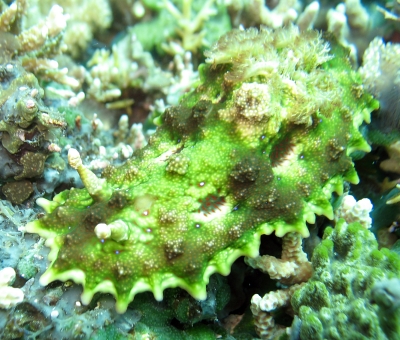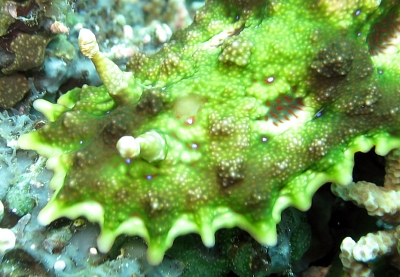Ceratosoma miamiranum from North Sulawesi
September 4, 2007
From: Sebastian Ferse


Hello Bill!
Here is another Ceratosoma miamiranum from North Sulawesi, Indonesia. In its shape it looks similar to the ones observed by Jim Anderson from West Papua and by Ahmad Zaki from Lembeh Strait (around the corner from where this one was observed), but its color is changed to perfectly match its surroundings, a brown Montipora coral and a green sponge. I wonder whether an individual is undergoing these color changes during its lifetime to match its surroundings? The reddish-brown individual from Lembeh Strait seems to point to this.
Locality: Muka Kampung, Gangga Island, 6 metres, North Sulawesi, Indonesia, Pacific Ocean, 23 June 2007, Shallow reef top with distinct coral/sponge community. Length: 10 cm. Photographer: Sebastian Ferse.
Sebastian Ferse
sebastian.ferse@zmt-bremen.de
Ferse, S.C.A., 2007 (Sep 4) Ceratosoma miamiranum from North Sulawesi. [Message in] Sea Slug Forum. Australian Museum, Sydney. Available from http://www.seaslugforum.net/find/20603
Dear Sebastian,
The wide colour variability in this species and the way it helps the animal blend into its background certainly suggests it has an ability to change colour, but I dont know of any studies on this. There are certainly other chromodorids which march the colour of their backgrouns - usually their food - very closely, such as Verconia verconis and some forms of Noumea haliclona, but in those cases the colour forms seemed to be genetically determined so you will find a yellow animal on a pink sponge and vice versa. even though when they are on their correctly coloured sponge they are almost invisible. There are also opisthobranchs that incorporate pigments and other elements from their food and so match the colour of their prey very well [see Colour Fact Sheet] but in the case of C. miamiranum I am not sure how it would do so because it would mean the sponge it feeds would also need to change colour to match the background colour as well. I guess that's not totally impossible, but it is starting to get a bit complicated. What we really need to find out is just what sponge C. miamiranum feeds on.
Best wishes,
Bill Rudman
Related messages
-
Re: Ceratosoma miamiranum from the Red Sea
From: Joe De Vroe, November 12, 2009 -
Ceratosoma miamiranum from the Philippines
From: Marcel Tanke, July 22, 2008 -
Re: Ceratosoma miamiranum from Indonesia
From: Teresa Zuberbühler, June 10, 2008 -
Ceratosoma miamirana from the Philippines
From: Sean Kearney, June 20, 2007 -
Another Ceratosoma miamirana from Indonesia
From: Jim Anderson, May 1, 2007 -
Ceratosoma miamirana from Indonesia
From: Ahmad Zaki, May 1, 2007 -
Re: Unidentified Nudibranch from Guam
From: Bob Abela, February 23, 2007 -
Re: Unidentified Nudibranch from Guam
From: Hugues Flodrops, February 19, 2007 -
Re: Unidentified Nudibranch from Guam
From: Clay Carlson, February 19, 2007 -
Ceratosoma miamirana from Heron Island
From: Julie Marshall, February 19, 2007 -
Unidentified Nudibranch from Guam
From: Bob Abela, February 16, 2007 -
Ceratosoma miamirana from Raja Ampat, Indonesia
From: Mike Krampf, February 16, 2007 -
Ceratosoma miamirana from Numoku Iki Tonga
From: Jennifer Eaton, April 6, 2006 -
Ceratosoma miamirana from the Red Sea
From: Matan Ninio, March 3, 2005 -
Ceratosoma miamirana from Malaysian Borneo
From: Grace Lim, November 12, 2003 -
Re: Ceratosoma miamirana and possible food
From: Mary Jane Adams, June 16, 2000 -
Ceratosoma miamirana from Papua New Guinea
From: Mary Jane Adams, June 14, 2000 -
Ceratosoma miamirana from Okinawa
From: Kazuko Matsuda, February 13, 2000
